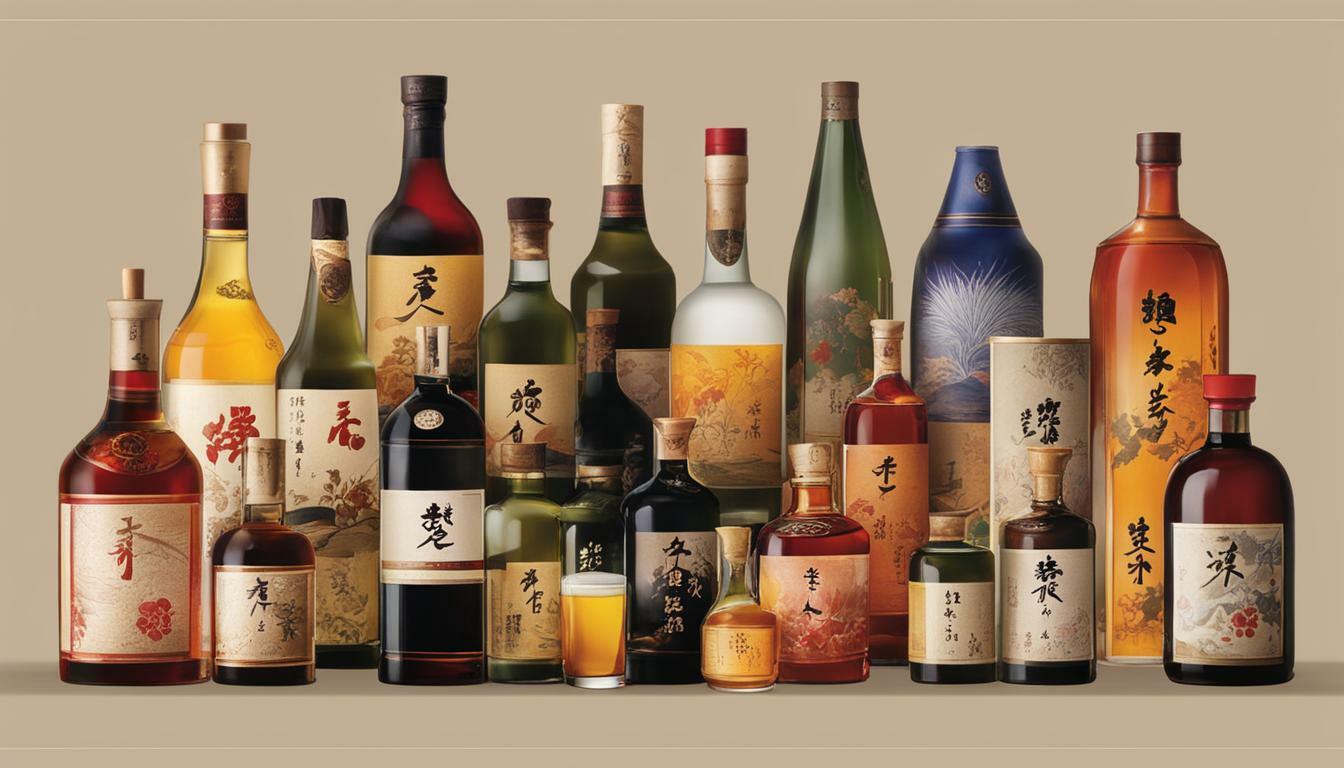Discover the Unique Taste of Shochu Made from Diverse Ingredients
Shochu is a Japanese spirit that offers a unique taste experience, thanks to its diverse range of ingredients. Made from various raw materials, shochu stands out among other spirits with its wide range of aromas and flavors.
For those who enjoy fruity and floral notes, sweet potato shochu is a perfect choice. Capturing the essence of sweet potatoes, this shochu variety bursts with flavors reminiscent of ripe fruits and blooming flowers. On the other hand, if you crave richness similar to aged whiskey or rum, barley shochu delivers with its deep and complex taste.
Rice shochu, with its light fragrance akin to ginjo sake, offers a refreshing and delicate flavor profile. Meanwhile, the distinct taste of unaged rum can be found in brown sugar shochu. And for a moderate aroma and character, Awamori, a unique shochu from Okinawa, takes center stage.
- Shochu is a Japanese spirit made from diverse ingredients.
- Sweet potato shochu offers fruity and floral notes.
- Barley shochu rivals aged whiskey or rum in richness.
- Rice shochu has a light fragrance similar to ginjo sake.
- Brown sugar shochu resembles unaged rum.
- Awamori, a unique shochu from Okinawa, has a moderate aroma and character.
Exploring the Diverse World of Shochu
Shochu made from a variety of ingredients like barley, sweet potato, rice, and brown sugar can provide a diverse range of flavors and aromas. Each type of shochu offers a unique taste adventure that captivates the senses and delights the palate. Let’s take a closer look at some of the most popular variations of shochu and the distinct characteristics they possess.
Barley Shochu
Barley shochu is often compared to aged whiskey or rum due to its rich and robust flavor profile. It boasts a complex combination of earthy and nutty notes, with a hint of sweetness that adds depth to each sip. Made from malted barley, this type of shochu is best enjoyed neat or on the rocks to fully appreciate its intricate flavors.
Sweet Potato Shochu
Sweet potato shochu offers a delightful fusion of fruity and floral aromas that are reminiscent of freshly harvested produce. Its slightly sweet taste is accompanied by a smooth and creamy texture, making it a popular choice among shochu enthusiasts. This versatile spirit can be enjoyed straight, mixed with water, or used as a base in cocktails for a unique twist.
Rice Shochu
Rice shochu has a light and delicate fragrance that is reminiscent of ginjo sake. It showcases the subtle nuances of rice, resulting in a clean and refined taste experience. This type of shochu pairs well with a wide variety of dishes and is perfect for those seeking a refreshing and mellow spirit to savor.
Brown Sugar Shochu
For those who enjoy the character of unaged rum, brown sugar shochu is a must-try. It offers a smooth and sweet flavor profile that is complemented by hints of caramel and molasses. This type of shochu is often enjoyed straight or as a base in tropical-inspired cocktails, adding a touch of warmth and richness to every sip.
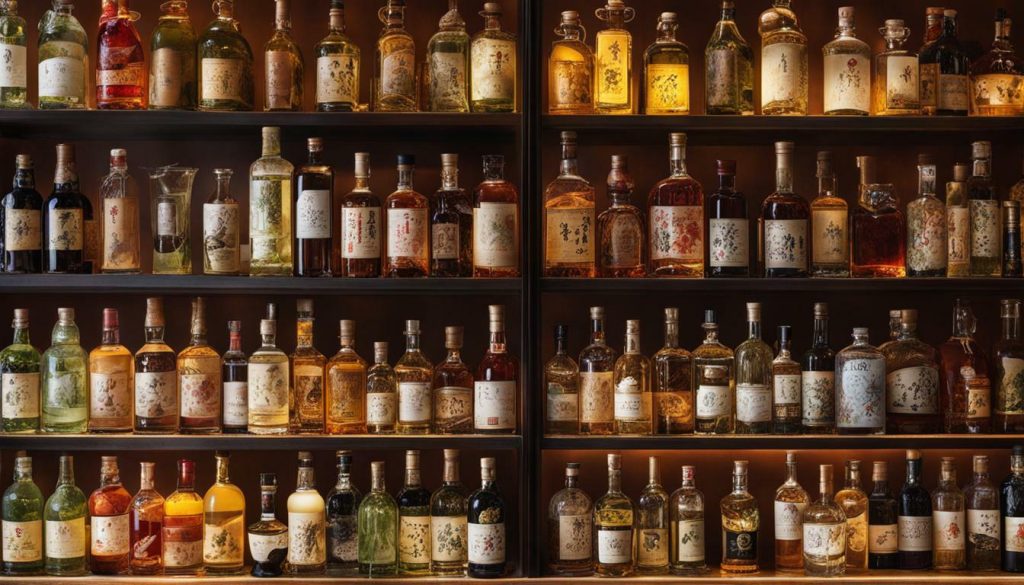
| Shochu Type | Ingredient | Flavors/Aromas |
|---|---|---|
| Barley Shochu | Malted Barley | Rich, Earthy, Nutty, Sweet |
| Sweet Potato Shochu | Sweet Potato | Fruity, Floral, Smooth, Creamy |
| Rice Shochu | Rice | Light, Fragrant, Clean, Refined |
| Brown Sugar Shochu | Brown Sugar | Smooth, Sweet, Caramel, Molasses |
As you can see, each type of shochu offers a distinct flavor profile, allowing you to embark on a taste journey like no other. Whether you prefer the rich complexity of barley shochu or the fruity allure of sweet potato shochu, there is a variant to suit every discerning palate. So why not explore the diverse world of shochu and discover your favorite?
The Role of Koji in Shochu Production
Koji plays a crucial role in the production of shochu, infusing it with distinct aromas, flavors, and sweetness. Derived from a fungus called Aspergillus oryzae, koji is responsible for breaking down the starches in the raw materials, such as barley, sweet potato, rice, or brown sugar, into fermentable sugars. This enzymatic process, known as saccharification, is essential for the fermentation of shochu and the development of its unique characteristics.
During the production of shochu, koji is mixed with the raw materials and water in a process called fermentation. The koji mold releases enzymes that convert the starches into sugars, which are then fermented by yeast to produce alcohol. This transformation not only creates the base alcohol for shochu but also generates a wide range of flavors and aromas.
The flavors and aromas imparted by koji vary depending on the type of ingredient used. For example, barley koji contributes to the rich and malty flavors found in barley shochu, while sweet potato koji adds fruity and floral notes to sweet potato shochu. Rice koji lends a light fragrance reminiscent of ginjo sake to rice shochu, and brown sugar koji enhances the rum-like characteristics of brown sugar shochu. The careful selection and treatment of koji are crucial in achieving the desired flavor profile of each shochu variety.
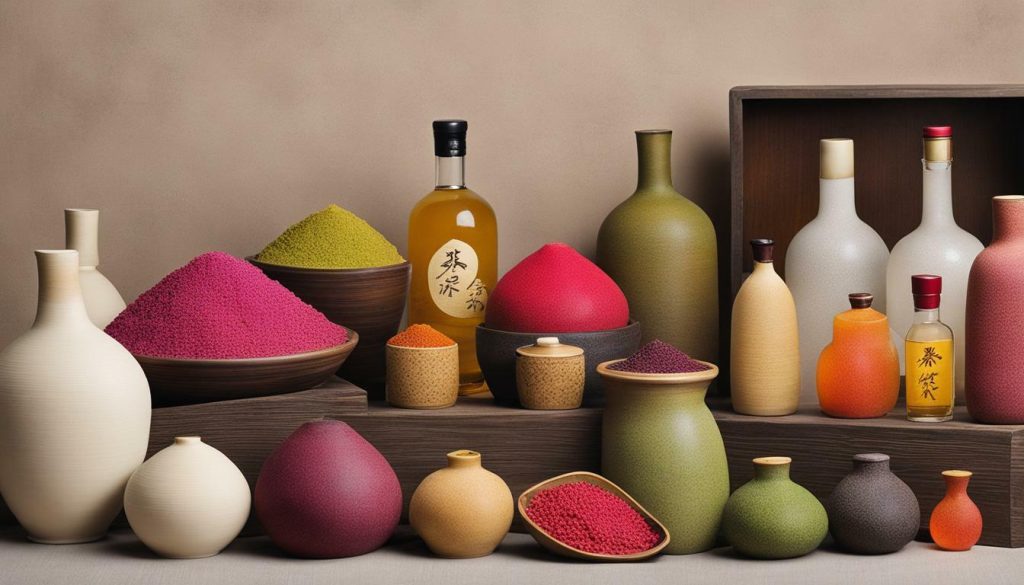
Distillation Methods and Filtration Techniques
The choice of distillation methods and filtration techniques can greatly influence the taste and character of shochu. Distillation is the process of heating the liquid to separate alcohol from other components, while filtration removes impurities and refines the spirit.
One common distillation method used in shochu production is the pot still, which allows for more contact between the liquid and the copper still, resulting in a richer and more complex flavor profile. Another method is the column still, which produces a lighter and cleaner style of shochu.
Filtration techniques further refine the spirit and can impact its flavor. One popular method is charcoal filtration, where the shochu is passed through a bed of activated carbon to remove any remaining impurities. This process not only clarifies the liquid but also helps to mellow and smooth out its taste.
It is important to note that different distillation methods and filtration techniques are used depending on the type of shochu being produced. For example, barley shochu is often distilled in pot stills and undergoes charcoal filtration, resulting in a robust and full-bodied spirit. On the other hand, rice shochu is typically produced using column stills and undergoes multiple filtrations to achieve a cleaner and more delicate flavor.
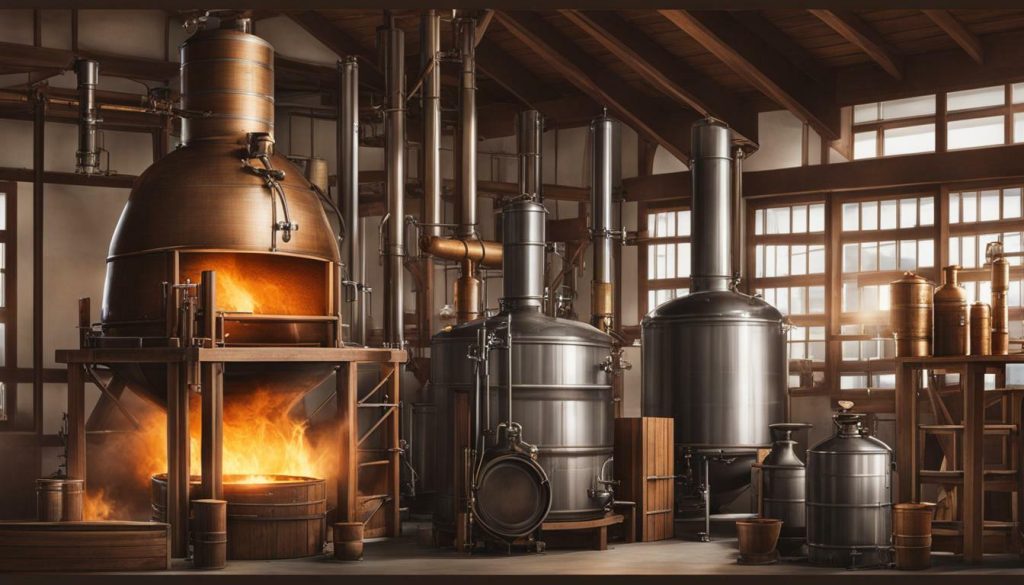
The choice of distillation methods and filtration techniques can greatly impact the taste and character of shochu. By using pot stills, the liquid has more contact with the copper, resulting in a richer and more complex flavor profile. On the other hand, column stills produce a lighter and cleaner style of shochu. Filtration techniques, such as charcoal filtration, not only remove impurities but also mellow and smooth out the taste. This combination of distillation and filtration methods allows for a wide range of shochu flavors and styles to suit different preferences.
In summary, the choice of distillation methods and filtration techniques plays a vital role in the production of shochu. Whether it’s the use of pot stills or column stills, or the application of charcoal filtration, each method contributes to the unique taste and character of the final product. Understanding these techniques can enhance your appreciation and enjoyment of shochu, allowing you to explore the diverse flavors and aromas that this Japanese spirit has to offer.
| Distillation Method | Filtration Technique | Taste Profile |
|---|---|---|
| Pot Still | Charcoal Filtration | Rich and full-bodied |
| Column Still | Multiple filtrations | Light and clean |
Shochu in Cocktails and Aging Possibilities
Shochu’s strong flavors make it a great addition to cocktails, and aging in different vessels enhances its complexity. Despite its low alcohol content, shochu boasts robust and distinctive flavors that can hold their own in a cocktail. Its versatility allows it to be mixed with a range of ingredients, from fruit juices and sodas to aromatic herbs and spices, creating unique and refreshing concoctions.
When it comes to aging shochu, different vessels offer unique characteristics. Tanks, pots, and barrels each contribute to the development of flavors and the overall profile of the spirit. Aging in tanks provides a clean and neutral environment, allowing the base ingredients to shine through. Pots, on the other hand, impart a touch of earthiness and richness, while barrels enhance the complexity with notes of oak and vanilla.
To fully appreciate the versatility of shochu in cocktails and the depth that aging brings, let’s explore a couple of examples:
- Shochu Highball: This classic Japanese cocktail combines shochu with soda water and a squeeze of citrus, such as lemon or yuzu. It’s a refreshing and light drink that highlights the unique flavors of shochu, making it perfect for warm summer evenings.
- Shochu Old Fashioned: For a more sophisticated cocktail, mix aged shochu with a touch of simple syrup, a few dashes of aromatic bitters, and a twist of orange peel. The aging process adds depth and complexity to the cocktail, elevating it to a premium sipping experience.
| Cocktail | Ingredients |
|---|---|
| Shochu Highball | Shochu, soda water, lemon or yuzu |
| Shochu Old Fashioned | Aged shochu, simple syrup, aromatic bitters, orange peel |
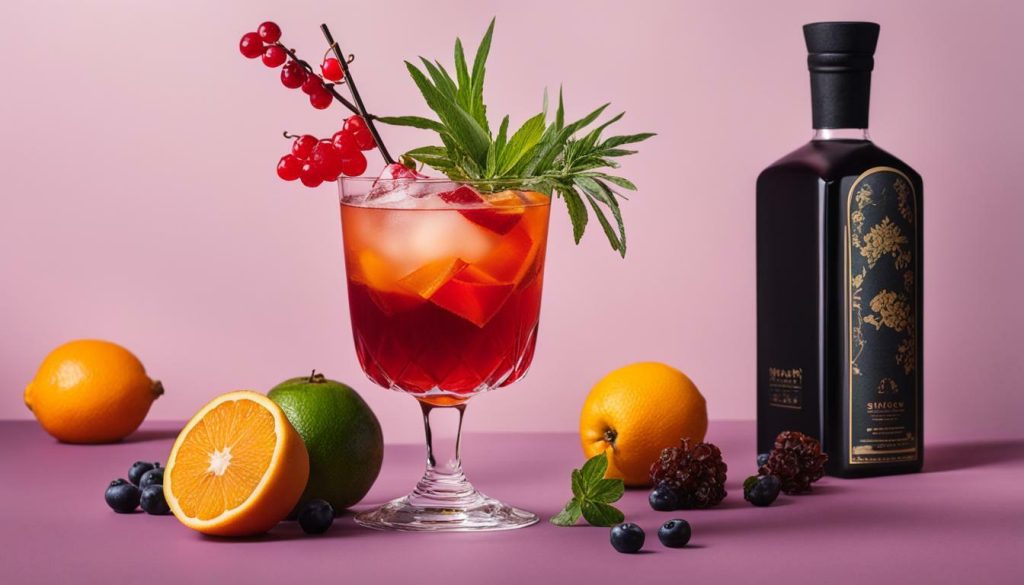
Whether you’re enjoying a refreshing highball or savoring the complexity of an aged shochu cocktail, the unique taste adventure of shochu made from diverse ingredients is sure to captivate your palate. Let your imagination soar as you experiment with different flavors, mixology techniques, and aging possibilities, adding your own twist to this fascinating Japanese spirit.
Enjoying Shochu: Mixing and Serving Options
There are various ways to enjoy shochu, such as mixing it with water at different temperatures or savoring it in highballs for a refreshing experience. The versatility of shochu allows for experimentation in creating unique cocktails that suit individual tastes. Whether you prefer a classic, straightforward mix or a more complex concoction, shochu provides a solid foundation to build upon.
For those who appreciate the traditional Japanese way of drinking shochu, mizuwari is a popular choice. Mizuwari, meaning “mixed with water,” involves combining shochu and water in a specific ratio to enhance the flavors and aromas. The addition of water also helps to lower the alcohol content, making it a lighter and more enjoyable drink. Each type of shochu has its own recommended ratio, so be sure to explore and find the perfect balance for your palate.
If you’re looking for a modern twist, highballs offer a refreshing alternative. A highball is a simple and satisfying mix of shochu and carbonated water, served over ice. The effervescence of the carbonated water brings out the subtle nuances of the shochu, creating a delightful and thirst-quenching beverage. You can experiment with different flavors by adding a splash of citrus juice, a sprig of herbs, or a dash of bitters to elevate the taste.
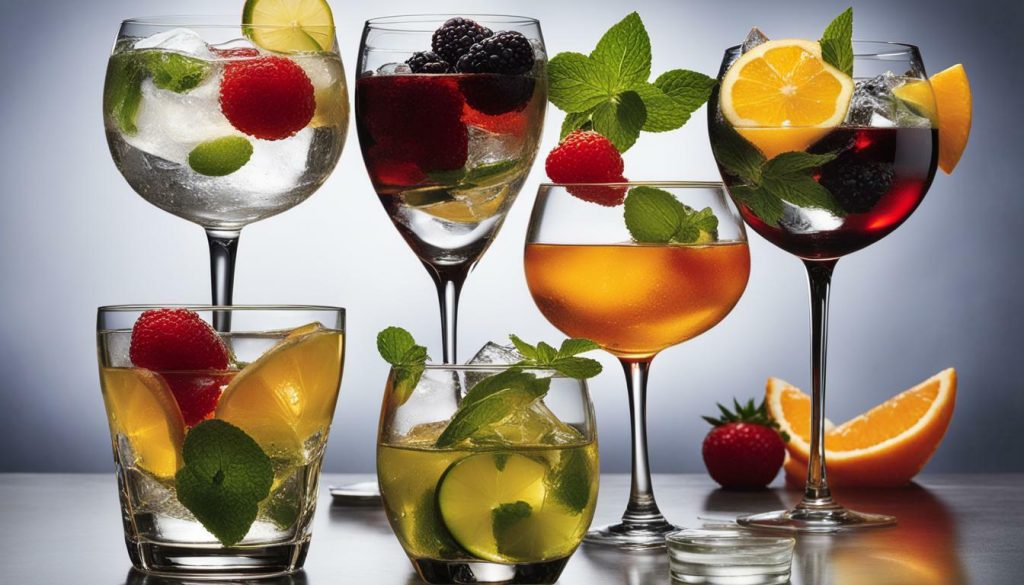
Conclusion
Shochu made from diverse ingredients offers a unique taste adventure, with a wide range of flavors and aromas to explore. This Japanese spirit stands out among other spirits due to its versatility, and the raw materials used play a crucial role in defining its character.
From sweet potato shochu with its fruity and floral notes to barley shochu that rivals aged whiskey or rum in richness, there is something for every palate. Rice shochu boasts a light fragrance reminiscent of ginjo sake, while brown sugar shochu offers a unique resemblance to unaged rum. And let’s not forget about the distinctive awamori from Okinawa, with its moderate aroma and character.
But it’s not just the ingredients that make shochu special. Koji, a key element in shochu production, contributes to its aroma, flavor, and sweetness, adding depth and complexity to this Japanese spirit. Distillation methods and filtration techniques further enhance the taste, resulting in a wide range of options for shochu enthusiasts.
Despite its lower alcohol content, shochu is an excellent choice for cocktails due to its strong flavors. Whether enjoyed in traditional highballs or mixed with water at different temperatures, shochu offers a refreshing taste experience that is sure to delight your senses. And for those seeking a more refined experience, aging shochu in tanks, pots, or barrels adds depth and mellows the flavor, creating a truly exceptional drinking experience.
So, why not embark on a taste adventure with shochu made from diverse ingredients? Discover the wide range of flavors and aromas that await you, and embrace this unique Japanese spirit for a one-of-a-kind experience.
FAQ
What is shochu made from?
Shochu can be made from diverse ingredients such as barley, sweet potato, rice, brown sugar, and more.
What flavors and aromas can be found in shochu?
The flavors and aromas of shochu vary depending on the raw materials used. Sweet potato shochu offers fruity and floral notes, barley shochu rivals aged whiskey or rum in richness, rice shochu has a light fragrance similar to ginjo sake, brown sugar shochu resembles unaged rum, and awamori from Okinawa has a moderate aroma and character.
What role does koji play in shochu production?
Koji, a key element in shochu production, contributes to its aroma, flavor, and sweetness, adding depth and complexity to the spirit.
How do distillation methods and filtration techniques impact the taste of shochu?
Distillation methods and filtration techniques can influence the flavor profile of shochu, resulting in a wide range of options for enthusiasts to explore.
Can shochu be used in cocktails?
Despite its low alcohol content, shochu can be used in cocktails due to its strong flavors.
How can aging in tanks, pots, or barrels affect the flavor of shochu?
Aging shochu in tanks, pots, or barrels adds depth and mellows the flavor, creating a unique taste experience.
How can shochu be enjoyed?
Shochu can be enjoyed mixed with water at different temperatures or served in highballs for a refreshing taste experience.
